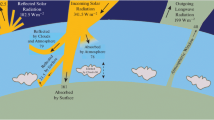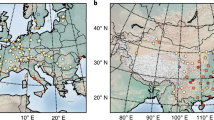Summary
Hitherto absorption of solar radiation has completely been disregarded when investigating how a CO2 increase of the atmosphere modifies the earth's climate. It can be shown that shortwave and longwave influence of a higher CO2 concentration counteract each other. The temperature change at the earth's surface is ΔT=+1.2°C when the present concentration is doubled.
Zusammenfassung
In den Untersuchungen über den Einfluß des atmosphärischen Kohlensäuregehaltes auf das Klima der Erde wurde bisher die Absorption kurzwelliger Sonnenstrahlung völlig außer acht gelassen. Es kann gezeigt werden, daß der kurzwellige und der langwellige Einfluß einer höheren CO2-Konzentration einander entgegenwirken. Für den Fall einer Verdopplung des gegenwärtigen Kohlensäuregehaltes wird eine Temperaturänderung an der Erdoberfläche von ΔT=+1,2°C berechnet.
Résumé
Jusqu'à présent l'absorption du rayonnement solaire de courte longuer d'onde n'a pas été prise en considération dans les recherches de l'influence de la concentration du CO2 de l'atmosphère sur le climat de la terre. Il peut être démontré que les influences du rayonnement de courte et de grande longueur d'onde agissent l'une contre l'autre. La variation de la température de la surface de la terre est ΔT=+1.2°C si la concentration présente est doublée.
Similar content being viewed by others
References
Bolin, B., andE. Erikson: Changes in the Carbon Dioxide Content of the Atmosphere and Sea due to Fossil Fuel Combustion. Rossby Memorial Vol., “The Atmosphere and the Sea in Motion”, Oxford Press, p. 130, 1959.
Bolin, B. andC. Keeling: Large Scale Atmospheric Mixing as Deduced from the Seasonal and Meridional Variations of Carbon Dioxide. Jour. Geophys. Res.68, 3899 (1963).
Callendar, G.: Variations of the Amount of Carbon Dioxide in Different Air Currents. Quart. Jour. Roy. Met. Soc.66, 287 (1940).
Callendar, G.: On the Amount of Carbon Dioxide in the Atmosphere. Tellus10, 243 (1958).
Erikson, E.: Possible Fluctuations in Atmospheric Carbon Dioxide Due to Changes in the Properties of the Sea. Jour. Geophys. Res.68, 3871 (1963).
Gebhart, R.: Ein theoretisches Modell für den Tagesgang der Atmosphären-temperaturen. Thesis, University of Munich, Germany. Beiträge Physik Atmosphäre38, 121–144 (1965).
Kaplan, L.: The Influence of Carbon Dioxide Variations on the Atmospheric Heat Balance. Tellus12, 204 (1960).
Kaplan, L.: Reply toGilbert N. Plass: Comment onLewis D. Kaplan: Influence of Carbon Dioxide variations of the Atmospheric Heat Balance. Tellus13, 301 (1961).
Kondrat'ev, K., andL. Nedovscova: On the Heat Radiation of Carbon Dioxide Gas in the Atmosphere. Izv. Acad. Nauk. USSR Ser. Geophys., No. 12 (1958).
Kondrat'ev, K., andH. Niilisk: On the Question of Carbon Dioxide Heat Radiation in the Atmosphere. Geofis. Pura Appl.46, 216 (1960).
Leith, H.: The Role of Vegetation in the Carbon Dioxide Content of the Atmosphere. Jour. Geophys. Res.68, 13 (1963).
Manabe, S., andF. Möller: On the Radiative Equilibrium and Heat Balance of the Atmosphere. Monthly Weather Rev.89, 503 (1961).
Möller, F.: On the Influence of Changes in the CO2 Concentration in Air on the Radiative Balance of the Earth's Surface and on the Climate. Jour. Geophys. Res.68, 3877 (1963).
Möller, F., andS. Manabe: Über das Strahlungsgleichgewicht der Atmosphäre. Zeitschr. Met.15, 3–8 (1961).
Plass, G.: The Influence of the 15 μ Carbon Dioxide Band on the Atmospheric Infra-red Cooling Rate. Quart. Jour. Roy. Met. Soc.82, 310 (1956).
Plass, G.: The Carbon Dioxide Theory of Climatic Change. Tellus8, 140 (1956).
Plass, G.: Effect of Carbon Dioxide Variations on Climate. Am. J. Phys.24, 376 (1956).
Plass, G.: The Influence of Infra-red Absorptive Molecules on the Climate. Ann. N.Y. Acad. Sci.95, 61 (1961).
Plass, G.: Comment onLewis D. Kaplan: Influence of Carbon Dioxide Variations on the Atmospheric Heat Balance. Tellus13, 296 (1961).
Takahashi, T.: Carbon Dioxide in the Atmosphere and in the Atlantic Ocean. Jour. Geophys. Res.66, 477 (1961).
Yamamoto, G.: On Radiation Chart. Sci. Rep. Tohuku Univ., Ser. 5, Geophysics4, No. 1 (1952).
Author information
Authors and Affiliations
Additional information
To the Memory of Professor Dr.Peregrin Zistler.
With 2 Figures
Rights and permissions
About this article
Cite this article
Gebhart, R. On the significance of the shortwave CO2-absorption in investigations concerning the CO2-theory of climatic change. Arch. Met. Geoph. Biokl. B. 15, 52–61 (1967). https://doi.org/10.1007/BF02319110
Received:
Issue Date:
DOI: https://doi.org/10.1007/BF02319110




